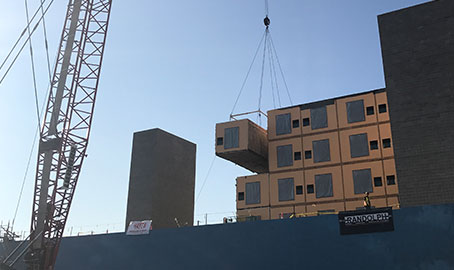
Robots are managing more construction tasks than ever before, and not just on factory floors. Machines that can operate independently are surveying sites, excavating tunnels and handling precision drilling. There are even reports of entire homes having been built with little to no human intervention.
However, robotics hasn’t completely taken over commercial construction. Humans are still very much in need in architectural design rooms, on construction sites, and for communication with everyone in between.
How Is Robotics Making Commercial Construction More Efficient?
This use of robotics in construction offers some significant advantages to contractors and clients alike, particularly when it comes to enhancing the efficiency and precision of building processes. In an industry known for its risks to workers, new technologies can enhance safety by handling hazardous materials, among other dangerous tasks. When workers are safer on and off work sites, everyone wins.
That doesn’t mean the same processes are used for every building project. But if you glimpse at what is happening in robotics, you will notice a range of ways that it is transforming how buildings are designed and built today.
Increased Efficiency through Automation
One of the main ways we see robotics in construction is in the prefabrication of buildings like the hotels and other large structures W. A. RANDOLPH, INC. has designed. That is because, when it comes to modular construction, automated technologies are commonly used to streamline tasks like cutting, shaping, and assembling.
The use of robotics in prefab processes guarantees more uniformity between spaces. This in turn minimizes delays and allows us to provide faster delivery of these kinds of projects.
Precision and Quality Control
When they interact with CAD models and 3D Building Information Modeling (BIM) software, robots can perform 3D printing, laser cutting and other customized tasks with a high degree of accuracy. Not only does this produce dimensions that align precisely with your design specifications, but it reduces the likelihood of errors when the components are being assembled.
Lower Labor Costs & Reduction in Material Waste
Robotics automates labor-intensive tasks, so it’s no surprise that it also has the potential to cut down on labor costs and minimize human error. Furthermore, automated systems optimize material usage and help ensure that materials are used efficiently.
Improved Safety and Risk Mitigation
Some robots are designed to handle the more dangerous tasks such as welding and lifting prefabricated components that are common sources of workplace injuries.
Streamlined Logistics with Intelligent Machines
Robots are used for the transport of large, heavy prefabricated components using autonomous vehicles and drones, improving logistical efficiency. These systems navigate using GPS and sensors, ensuring that materials are delivered safely and on time, reducing risks and delays associated with manual handling and transportation.
Potential Limitations of Robotics: What This Means for Clients
When pre-programmed gantry systems are used to weld beams and hoist raw materials, it’s easy to see why technology has the potential to improve productivity and reduce errors. But live workers are still doing a bulk of the work that is happening on most construction sites:
- Removing debris and prepping the site
- Loading and unloading building materials
- Assembling scaffolding and other temporary structures
- Operating smaller tools and equipment
- Assisting tradespeople and other workers
In the beginning stages, human imagination is still behind building design, particularly for clients in search of something more individualized. Throughout the project, when the client wants a collaborator and problem-solver, they will look to the people, not the robots, for those essential qualities.
Ask Chicago-Based W. A. RANDOLPH, INC., About Their Construction Safety Programs
The bigger technology advantages occur when your contractor has the expertise to leverage intelligent machines in areas such as manufacturing, transportation, and prefab assembly processes. At W. A. RANDOLPH, INC., our team of specialists is happy to explain how our automated systems lead to faster project timelines and reduced labor costs.
Review our past projects online, or call 847-856-0123 to discuss the range of tools and technologies we will employ on your next building design.




